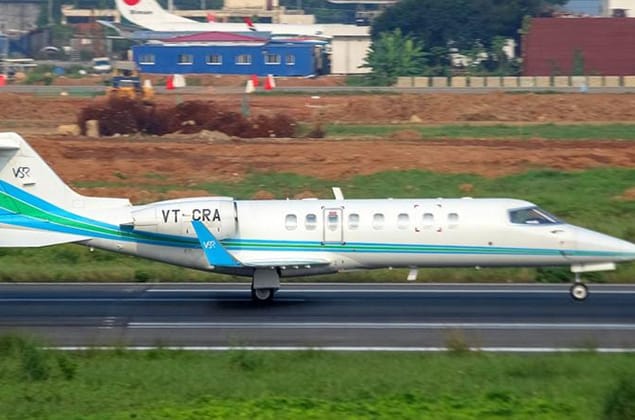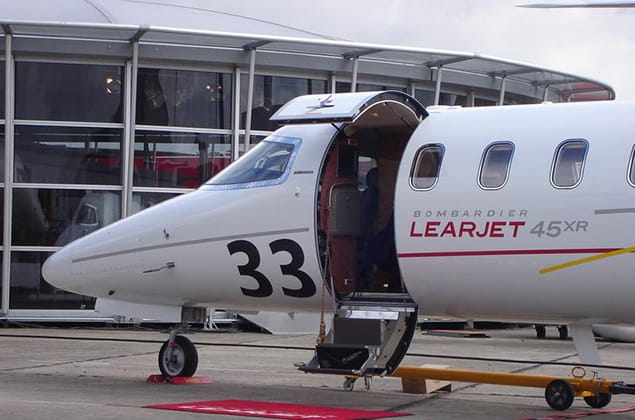Learjet 45XR Specifications & Booking
Available Empty Leg Flights on the Learjet 45XR
Hailey, Friedman Memorial (SUN), ID, US
Austin, Bergstrom International (AUS), TX, US
22.12.2025
Learjet 45XR
9
Charleston, Air Force Base-International (CHS), SC, US
Dallas, Addison (ADS), TX, US
23.12.2025
Learjet 45XR
8
Panama City, Northwest Florida Beaches International (ECP), FL, US
Charleston, Air Force Base-International (CHS), SC, US
27.12.2025
Learjet 45XR
9
Belfast, Belfast International Airport (BFS), GB
Bournemouth, Bournemouth Airport (BOH), GB
28.12.2025
Learjet 45XR
8
Dallas, Addison (ADS), TX, US
Panama City, Northwest Florida Beaches International (ECP), FL, US
31.12.2025
Learjet 45XR
9
Overview of the Learjet 45XR
The Learjet 45XR is a business jet manufactured by Bombardier, a Canadian aerospace company. This versatile aircraft is designed for private charter operations, VIP transport, and light cargo transport. Its primary purpose is to provide a reliable, efficient, and comfortable flying experience for passengers. The first flight of the Learjet 45XR took place in August 2005, and it received certification from Transport Canada and the FAA in May 2006.
Technical Specifications
The Learjet 45XR has a length of 58 feet 3 inches (17.8 meters), a wingspan of 55 feet 7 inches (16.9 meters), and an overall height of 18 feet 1 inch (5.5 meters). Its empty weight is approximately 14,300 pounds (6,494 kilograms), while its maximum takeoff weight is around 31,500 pounds (14,256 kilograms).
- Dimensions:
- Length: 58 feet 3 inches (17.8 meters)
- Wingspan: 55 feet 7 inches (16.9 meters)
- Height: 18 feet 1 inch (5.5 meters)
- Weight:
- Empty weight: approximately 14,300 pounds (6,494 kilograms)
- Maximum takeoff weight: around 31,500 pounds (14,256 kilograms)
- Engines:
- Type: Honeywell TFE731-40
- Thrust: 4,400 pounds-force each
- Fuel efficiency: approximately 0.35 pounds of fuel per mile at cruise altitude
- Performance:
- Maximum speed: Mach 0.80 (around 530 mph or 853 km/h)
- Range: approximately 3,000 nautical miles (5,556 kilometers) at maximum fuel capacity
- Cruising altitude: up to 45,000 feet (13,716 meters)
- Capacity:
- Passengers: up to 8 passengers in a typical seating configuration
- Cargo: capacity for up to 1,500 pounds (680 kilograms) of cargo
- Crew: typically one or two pilots
Design and Features
The Learjet 45XR features a unique design that combines aerodynamic efficiency with exceptional comfort. The aircraft's advanced materials and systems provide a smooth, quiet ride and minimize fatigue for passengers. Its innovative avionics suite includes advanced navigation and communication tools to ensure safe and efficient flight operations.
History and Development
- Key milestones:
- First flight: August 2005
- Certification: May 2006 (Transport Canada and FAA)
- Entry into service: June 2007
- Challenges faced during development:
- Integration of advanced avionics and systems
- Optimization for efficiency and performance
- Maintenance-friendly design to reduce costs
- Significant upgrades or variants:
- Learjet 45XR-1: an upgraded variant with improved engines and avionics
- Learjet 45XRS: a stretched version with increased range and payload capacity
Operational Use
The Learjet 45XR is used by various airlines, charter operators, and private individuals for both business and leisure purposes. Its versatility and reliability make it an ideal choice for flying between cities or short-range missions. Some popular routes and missions include:
- Airlines/organizations that operate the Learjet 45XR:
- Private charter operators
- VIP transport services
- Cargo transport companies
- Popular routes or missions:
- Short-range flights within North America and Europe
- Long-range flights between continents with minimal refueling stops
- Role in aviation history:
- Pioneering the development of advanced business jets
- Setting new standards for comfort, efficiency, and reliability
Interesting Facts
- Famous flights or events:
- The Learjet 45XR set a record for the fastest flight around the world in 2008
- The aircraft has been used for medical evacuation missions and humanitarian relief efforts
- Pop culture appearances:
- The Learjet 45XR appeared in the movie "The Aviator" (2004) starring Leonardo DiCaprio
- The aircraft was featured in an episode of the TV series "Entourage" (2010)
Conclusion
In conclusion, the Learjet 45XR is a pioneering business jet that has set new standards for comfort, efficiency, and reliability. Its advanced design and systems make it an ideal choice for short-range to long-range missions, and its versatility has made it a popular option among airlines, charter operators, and private individuals alike. With its impressive performance capabilities, the Learjet 45XR is sure to remain a dominant force in the business aviation industry for years to come.





